How High Is the Recreation Value of Successional Forests Growing Spontaneously on Coal Mine Spoil Heaps?
Abstract
1. Introduction
1.1. Post-Mining Reclamation
1.2. Measuring Environmental Preferences
1.3. Research Purpose
2. Materials and Methods
2.1. Study Site
2.2. Participants
2.3. Materials
2.3.1. Evaluated Forests and Their Visual Representations
2.3.2. Measures of Recreation Value of Reclaimed Forests
Origin of the Forest
Age of the Forest
2.4. Design and Procedure
3. Results
3.1. Direct Measure of Recreation Value—Rating of Forest Attractiveness
3.1.1. Mean Ratings of Recreation Value
3.1.2. Ordinal Regression Model
3.2. Indirect Measure of Recreation Value—Choice of a Locality for Recreation
3.2.1. Multinomial Regression Model
3.2.2. Predicted Recreation Values
4. Discussion
4.1. Recreation Value of Successional Forests
4.2. The Method
4.3. Limitation of Our Research
4.4. Succession in the Context of Other Ecosystem Services
5. Conclusions
Supplementary Materials
Author Contributions
Funding
Institutional Review Board Statement
Informed Consent Statement
Data Availability Statement
Conflicts of Interest
Appendix A
| 2 × 2 factorial design | 2. Manipulated Factor | |||
| Information on the origin of the forest | ||||
| Displayed | Not displayed | |||
| 1. Manipulated Factor | Successional forest | At age 15 years | 226 (26%) | 224 (26%) |
| At age 35 years | 190 (22%) | 229 (26%) | ||
References
- Bufka, A.; Rosecký, D.; Bednář, P. Uhlí, Koks a Brikety v České Republice v Roce 2007; Ministry of Industry and Trade: Prague, Czech, 2009. [Google Scholar]
- Czech Mining Authority Přehled dobývacích Prostorů v České Republice. Available online: http://www.cbusbs.cz/cs/component/k2/item/107 (accessed on 29 November 2020).
- Routa, M. Ekonomická Náročnost Sanace a Rekultivace v Oblasti Sokolovska. Ph.D. Thesis, Czech University of Life Sciences, Prague, Czech Republic, 2009. Available online: https://www.fld.czu.cz/dl/47003 (accessed on 17 January 2021).
- Ministry of Finance of the Czech Republic Informace na Žádost Podle Zákona č. 106/1999 Sb., o Svobodném Přístupu k Informacím, č.j. MF-18169/2018/10/741 IK. 2018. Available online: https://www.mfcr.cz/assets/cs/media/Informace-zadost-106_2018-07-27_Info-106-99-MF-18169-2018-10-741-IK.pdf (accessed on 17 January 2021).
- Karjalainen, E. The Visual Preferences for Forest Regeneration and Field Afforestation—Four Case Studies in Finland. Ph.D. Thesis, Finnish Forest Research Institute and Faculty of Biosciences of University of Helsinki, Helsinki, Finland, 2006. [Google Scholar] [CrossRef]
- Gundersen, V.S.; Frivold, L.H. Public preferences for forest structures: A review of quantitative surveys from Finland, Norway and Sweden. Urban For. Urban Green. 2008, 7, 241–258. [Google Scholar] [CrossRef]
- Pukkala, T.; Kellomäki, S.; Mustonen, E. Prediction of the amenity of a tree stand. Scand. J. For. Res. 1988, 3, 533–544. [Google Scholar] [CrossRef]
- Silvennoinen, H.; Alho, J.; Kolehmainen, O.; Pukkala, T. Prediction models of landscape preferences at the forest stand level. Landsc. Urban Plan. 2001, 56, 11–20. [Google Scholar] [CrossRef]
- Silvennoinen, H.; Pukkala, T.; Tahvanainen, L. Effect of Cuttings on the Scenic Beauty of a Tree Stand. Scand. J. For. Res. 2002, 17, 263–273. [Google Scholar] [CrossRef]
- Tyrväinen, L.; Silvennoinen, H.; Kolehmainen, O. Ecological and aesthetic values in urban forest management. Urban For. Urban Green. 2003, 1, 135–149. [Google Scholar] [CrossRef]
- Upton, V.; Dhubháin, Á.N.; Bullock, C. Preferences and values for afforestation: The effects of location and respondent understanding on forest attributes in a labelled choice experiment. For. Policy Econ. 2012, 23, 17–27. [Google Scholar] [CrossRef]
- Nielsen, A.B.; Olsen, S.B.; Lundhede, T. An economic valuation of the recreational benefits associated with nature-based forest management practices. Landsc. Urban Plan. 2007, 80, 63–71. [Google Scholar] [CrossRef]
- Valasiuk, S.; Czajkowski, M.; Giergiczny, M.; Żylicz, T.; Veisten, K.; Landa Mata, I.; Halse, A.H.; Elbakidze, M.; Angelstam, P. Is forest landscape restoration socially desirable? A discrete choice experiment applied to the Scandinavian transboundary Fulufjället National Park Area. Restor. Ecol. 2018, 26, 370–380. [Google Scholar] [CrossRef]
- Kaplan, R.; Herbert, E.J. Cultural and sub-cultural comparisons in preferences for natural settings. Landsc. Urban Plan. 1987, 14, 281–293. [Google Scholar] [CrossRef]
- Zheng, B.; Zhang, Y.; Chen, J. Preference to home landscape: Wildness or neatness? Landsc. Urban Plan. 2011, 99, 1–8. [Google Scholar] [CrossRef]
- Purcell, A.T.; Lamb, R.J.; Peron, E.M.; Falchero, S. Preference or preferences for landscape? J. Environ. Psychol. 1994, 14, 195–209. [Google Scholar] [CrossRef]
- Hartig, T.; Staats, H. The need for psychological restoration as a determinant of environmental preferences. J. Environ. Psychol. 2006, 26, 215–226. [Google Scholar] [CrossRef]
- Kohlová, M.B.; Melichar, J. Environmental preferences for forest growth in post-mining landscape. J. Landsc. Manag. 2017, 8, 14–19. [Google Scholar]
- Tahvanainen, L.; Tyrväinen, L.; Ihalainen, M.; Vuorela, N.; Kolehmainen, O. Forest management and public perceptions—Visual versus verbal information. Landsc. Urban Plan. 2001, 53, 53–70. [Google Scholar] [CrossRef]
- Shuttleworth, S. The use of photographs as an environmental presentation medium in landscape studies. J. Environ. Manag. 1980, 11, 61–76. [Google Scholar]
- Stamps, A.E. Use of photographs to simulate environments: A meta-analysis. Percept. Mot. Skills 1990, 71, 907–913. [Google Scholar] [CrossRef]
- Palmer, J.F.; Hoffman, R.E. Rating reliability and representation validity in scenic landscape assessments. Landsc. Urban Plan. 2001, 54, 149–161. [Google Scholar] [CrossRef]
- Zube, E.H.; Pitt, D.G.; Anderson, T.W. Perception and Measurement of Scenic Resources in the Southern Connecticut River Valley. Landsc. Res. 1974, 1, 10–11. [Google Scholar] [CrossRef]
- Kroh, D.P.; Gimblett, R.H. Comparing live experience with pictures in articulating landscape preference. Landsc. Res. 1992, 17, 58–69. [Google Scholar] [CrossRef]
- Svobodova, K.; Sklenicka, P.; Molnarova, K.; Salek, M. Visual preferences for physical attributes of mining and post-mining landscapes with respect to the sociodemographic characteristics of respondents. Ecol. Eng. 2012, 43, 34–44. [Google Scholar] [CrossRef]
- Filova, L.; Vojar, J.; Svobodova, K.; Sklenicka, P. The effect of landscape type and landscape elements on public visual preferences: Ways to use knowledge in the context of landscape planning. J. Environ. Plan. Manag. 2015, 58, 2037–2055. [Google Scholar] [CrossRef]
- Simonic, T. Preference and perceived naturalness in visual perception of naturalistic landscapes. Zb. Biotech. Fak. Univ. Ljublj. Kmet. 2003, 81, 369–389. [Google Scholar]
- Harris, V.; Kendal, D.; Hahs, A.K.; Threlfall, C.G. Green space context and vegetation complexity shape people’s preferences for urban public parks and residential gardens. Landsc. Res. 2018, 43, 150–162. [Google Scholar] [CrossRef]
- Daniel, T.C.; Meitner, M.M. Representational validity of landscape visualizations: The effects of graphical realism on perceived scenic beauty of forest vistas. J. Environ. Psychol. 2001, 21, 61–72. [Google Scholar] [CrossRef]
- Champ, P.A. Collecting Nonmarket Valuation Data. In A Primer on Nonmarket Valuation. The Economics of Non-Market Goods and Resources; Champ, P.A., Boyle, K.J., Brown, T.C., Eds.; Springer Netherlands: Dordrecht, The Netherlands, 2017; pp. 55–82. [Google Scholar] [CrossRef]
- Bateman, I.J.; Carson, R.T.; Day, B.; Hanemann, W.M. Economic Valuation with Stated Preference Techniques: A Manual; Edward Elgar: Cheltenham, UK, 2004; ISBN 1843768526. [Google Scholar]
- Freeman, A.M.I. The Measurement of Environmental and Resource Values: Theory and Methods; Resources for the Future: Washington, DC, USA, 2003; ISBN 9781891853623. [Google Scholar]
- Christie, M.; Hanley, N.; Hynes, S. Valuing enhancements to forest recreation using choice experiment and contingent behaviour methods. J. For. Econ. 2007, 13, 75–102. [Google Scholar] [CrossRef]
- Hensher, D.A.; Rose, J.M.; Greene, W.H. Applied Choice Analysis: A Primer; Cambridge University Press: Cambridge, MA, USA, 2005. [Google Scholar]
- Holmes, T.P.; Adamowicz, W.L.; Carlsson, F. Choice Experiments. In A Primer on Nonmarket Valuation. The Economics of Non-Market Goods and Resources; Champ, P., Boyle, K., Brown, T., Eds.; Springer Netherlands: Dordrecht, The Netherlands, 2017; pp. 133–186. [Google Scholar] [CrossRef]
- Czajkowski, M.; Buszko-Briggs, M.; Hanley, N. Valuing changes in forest biodiversity. Ecol. Econ. 2009, 68, 2910–2917. [Google Scholar] [CrossRef]
- Czajkowski, M.; Giergiczny, M.; Greene, W.H. Learning and Fatigue Effects Revisited: Investigating the Effects of Accounting for Unobservable Preference and Scale Heterogeneity. Land Econ. 2014, 90, 324–351. [Google Scholar] [CrossRef]
- Bartczak, A.; Lindhjem, H.; Navrud, S.; Zandersen, M.; Żylicz, T. Valuing forest recreation on the national level in a transition economy: The case of Poland. For. Policy Econ. 2008, 10, 467–472. [Google Scholar] [CrossRef]
- Frouz, J.; Pižl, V.; Cienciala, E.; Kalčík, J. Carbon storage in post-mining forest soil, the role of tree biomass and soil bioturbation. Biogeochemistry 2009, 94, 111–121. [Google Scholar] [CrossRef]
- Frouz, J.; Mudrák, O.; Reitschmiedová, E.; Walmsley, A.; Vachová, P.; Šimáčková, H.; Albrechtová, J.; Moradi, J.; Kučera, J. Rough wave-like heaped overburden promotes establishment of woody vegetation while leveling promotes grasses during unassisted post mining site development. J. Environ. Manag. 2018, 205, 50–58. [Google Scholar] [CrossRef]
- de Val, G.F.; Atauri, J.A.; de Lucio, J.V. Relationship between landscape visual attributes and spatial pattern indices: A test study in Mediterranean-climate landscapes. Landsc. Urban Plan. 2006, 77, 393–407. [Google Scholar] [CrossRef]
- Tveit, M.; Ode, Å.; Fry, G. Key concepts in a framework for analysing visual landscape character. Landsc. Res. 2006, 31, 229–255. [Google Scholar] [CrossRef]
- Melichar, J. The economic valuation of the change in forest quality in the Jizerske hory mountains: A contingent behavior model. J. Landsc. Manag. 2014, 5, 6. [Google Scholar]
- Louviere, J.; Hensher, D.A.; Swait, J.D. Stated Choice Methods; Cambridge University Press: Cambridge, MA, USA, 2000; ISBN 0 511 01173 3 virtual. [Google Scholar]
- Ben-Akiva, M.E.; Lerman, S.R. Discrete Choice Analysis: Theory and Application to Travel Demand; MIT Press: Cambridge, MA, USA, 1985. [Google Scholar]
- Han, K.T. Responses to six major terrestrial biomes in terms of scenic beauty, preference, and restorativeness. Environ. Behav. 2007, 39, 529–556. [Google Scholar] [CrossRef]
- Sklenicka, P.; Molnarova, K. Visual perception of habitats adopted for post-mining landscape rehabilitation. Environ. Manag. 2010, 46, 424–435. [Google Scholar] [CrossRef]
- Kohlová, M.B.; Máca, V.; Melichar, J. Post-mining nature. When visual attractiveness is not enough. In International Conference of Environmental Psychology. Protecting People and Planet through Social and Behavioural Science (ICEP 2019); University of Plymouth: Plymouth, UK, 2019. [Google Scholar]
- Jara-Díaz, S.R. Allocation and Valuation of Travel-Time Savings. In Handbook of Transport Modelling; Hensher, D.A., Button, K.J., Eds.; Elsevier Science Ltd.: Oxford, UK, 2000; pp. 303–319. [Google Scholar]
- Mokhtarian, P.L.; Salomon, I.; Redmond, L.S. Understanding the demand for travel: It’s not purely “derived”. Innovation 2001, 14, 355–380. [Google Scholar] [CrossRef]
- Mudrák, O.; Frouz, J.; Velichová, V. Understory vegetation in reclaimed and unreclaimed post-mining forest stands. Ecol. Eng. 2010, 36, 783–790. [Google Scholar] [CrossRef]
- Frouz, J. (Ed.) Soil Biota and Ecosystem Development in Post Mining Sites; CRC Press: Boca Raton, FL, USA, 2013; ISBN 9781466599338. [Google Scholar]
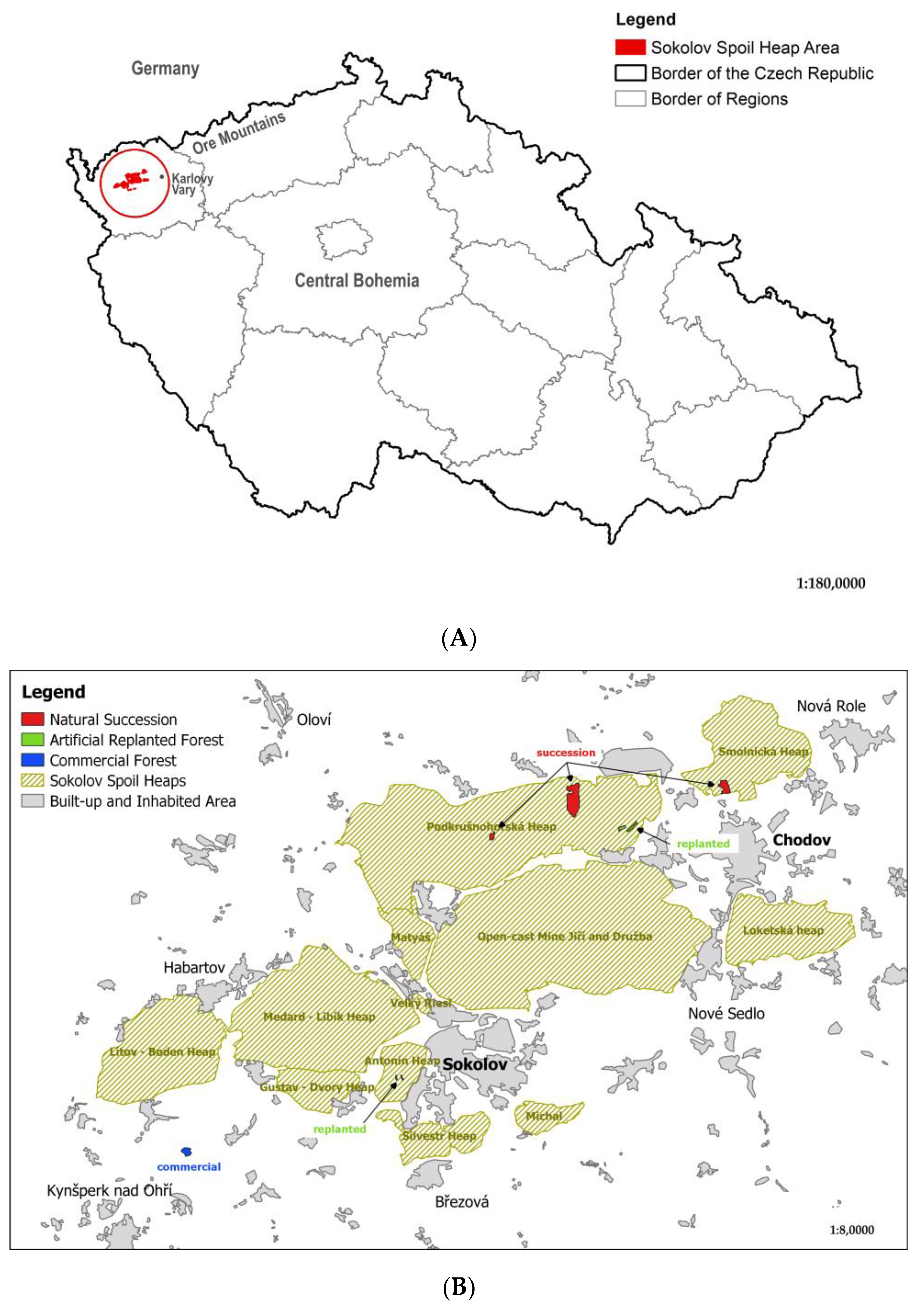
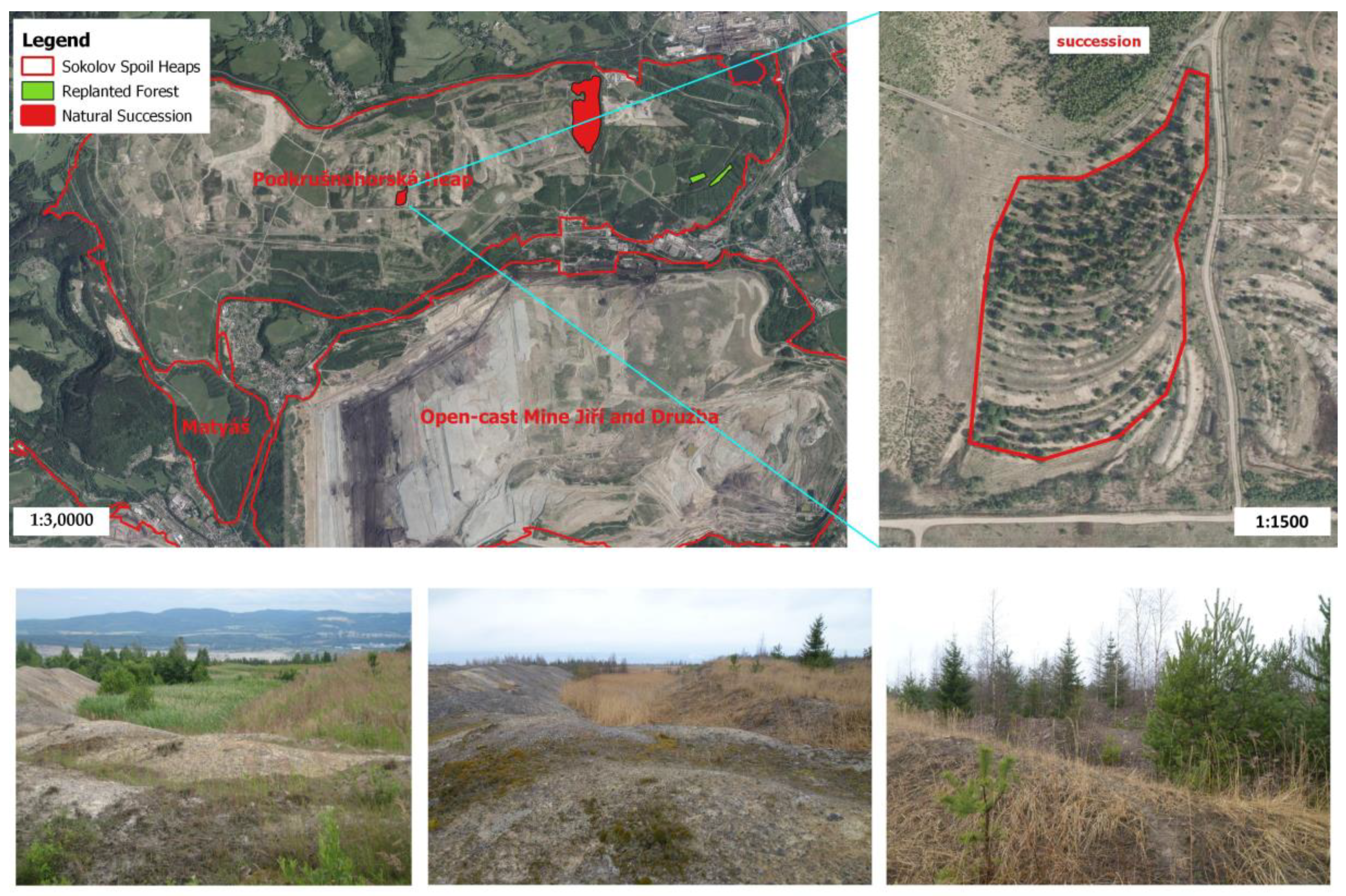
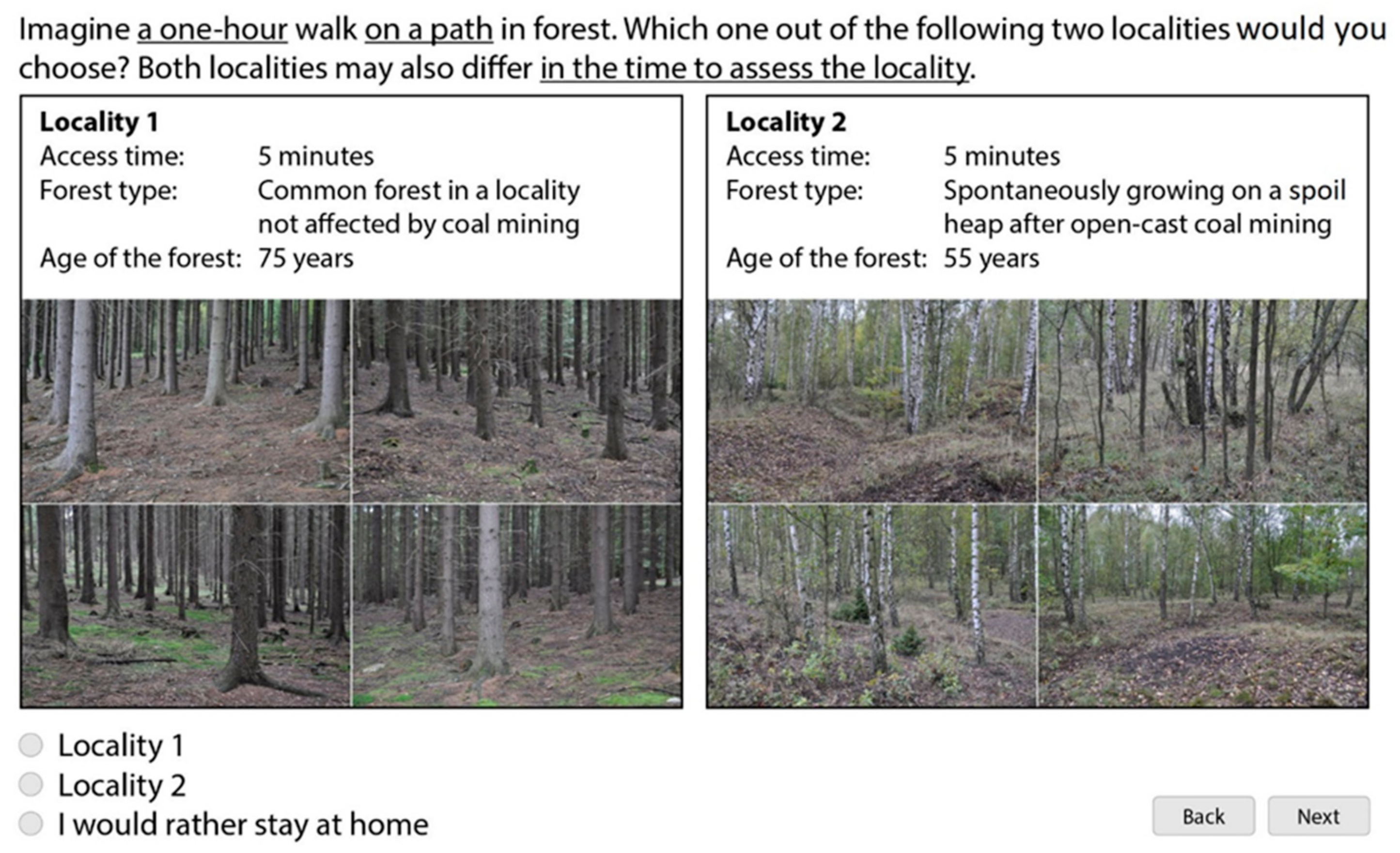
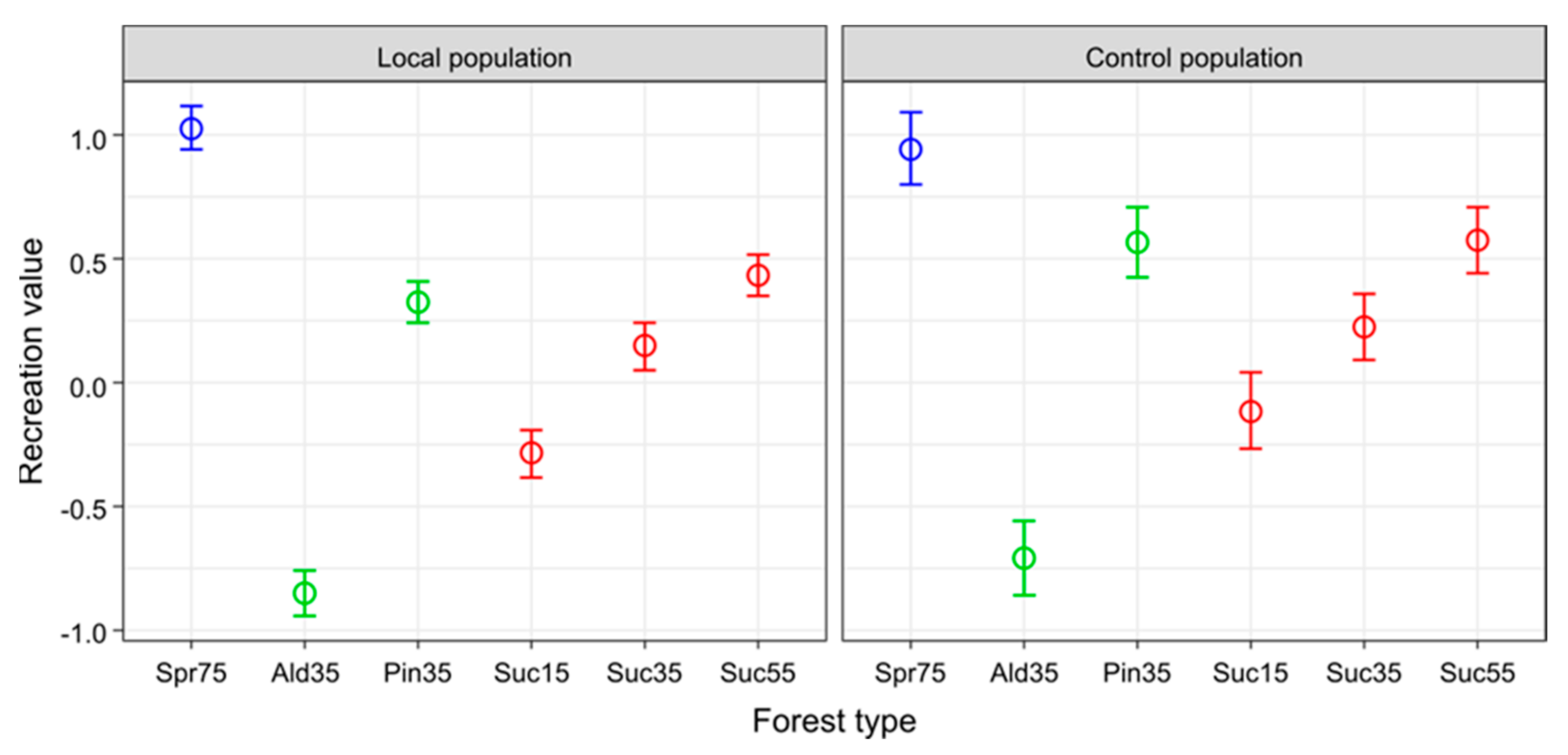
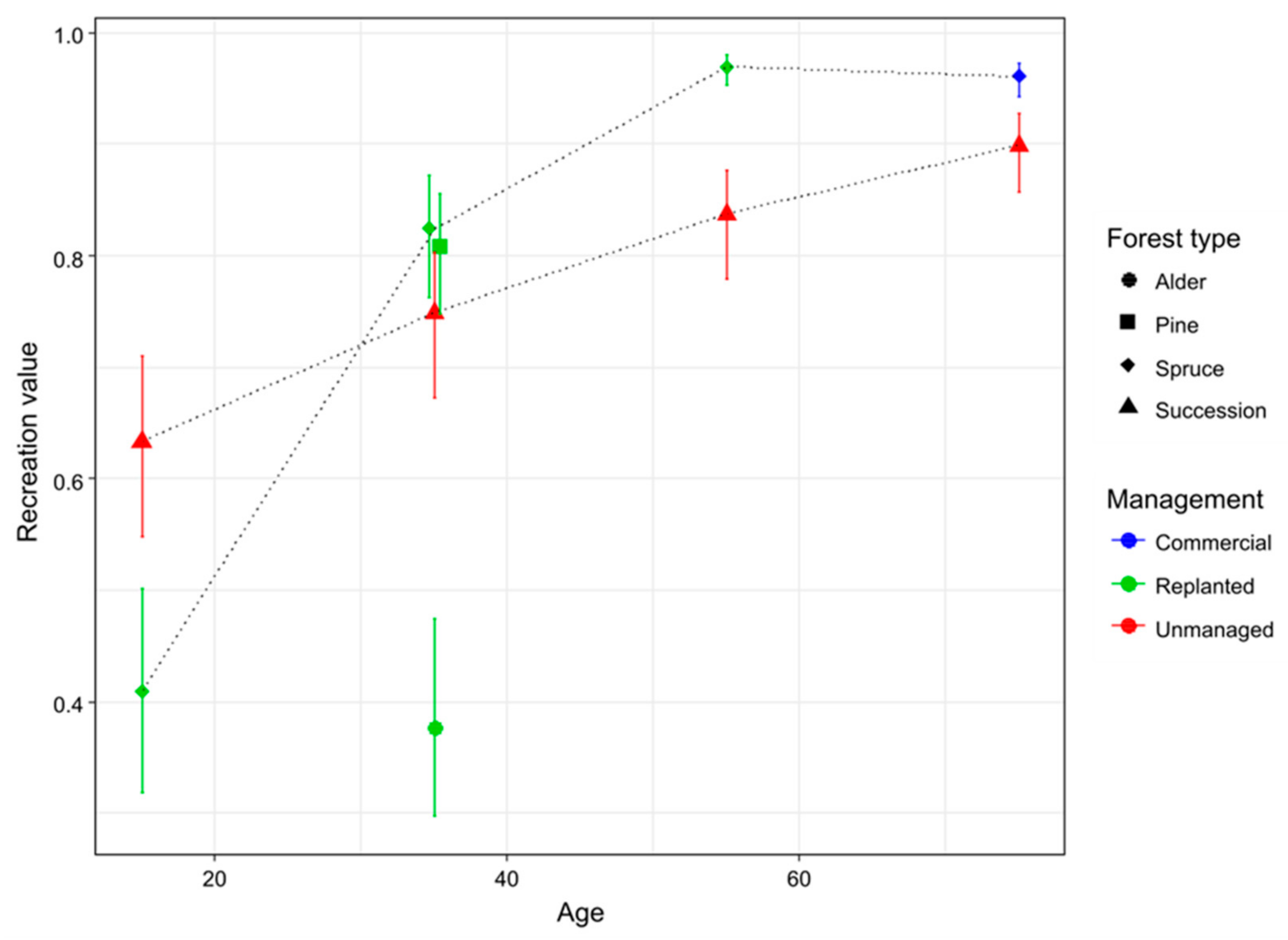
| Acronym of Forest Type 1 | Attributes | ||
|---|---|---|---|
| Prevailing Tree Species4 | Origin of the Forest5,6 | Age5,7 | |
| Reference commercial timber forest: | |||
| Spr75 | spruce | commercial timber forest | 75 years |
| Reclaimed forest: | |||
| Spr35 2 | spruce | planted on an open-cast coal mine spoil heap | 35 years |
| Spr15 2 | spruce | planted on an open-cast coal mine spoil heap | 15 years |
| Pin35 | pine | planted on an open-cast coal mine spoil heap | 35 years |
| Ald35 | alder | planted on an open-cast coal mine spoil heap | 35 years |
| Unmanaged forest: | |||
| Suc55 | mixed | spontaneously growing on an open-cast coal mine spoil heap | 55 years |
| Suc35 3 | mixed | spontaneously growing on an open-cast coal mine spoil heap | 35 years |
| Suc15 3 | mixed | spontaneously growing on an open-cast coal mine spoil heap | 15 years |
| Variable Name | Type | Description |
|---|---|---|
| Ordinal logistic regression | ||
| Attractiveness 1 | ordinal | How would you like walking on forest way in this forest for one hour? (from −2 = not at all to +2 = very attractive) |
| Spr75 2 | dummy | commercial spruce forest at age 75 years as reference forest |
| Suc15 | dummy | 1 = natural succession at age 15 years; 0 = other forest types |
| Suc35 | dummy | 1 = natural succession at age 35 years; 0 = other forest types |
| Suc55 | dummy | 1 = natural succession at age 55 years; 0 = other forest types |
| Ald35 | dummy | 1 = alder plantation at age 35 years; 0 = other forest types |
| Pin35 | dummy | 1 = pine plantation at age 35 years; 0 = other forest types |
| Order | ordinal | higher of order, in which the forest was evaluated in Part 1 (1 = the first in evaluation; 5 = the last in evaluation) |
| Label | dummy | information on the origin of the forest, if the forest has been replanted or has been spontaneously growing on spoil heaps (1 = information was present; 0 = without information) |
| Multinomial logistic regression | ||
| Choice 1 | dummy | choice realized in DCE 3 (1 = true;0 = false) |
| Spruce | dummy | 1 = spruce forests at all ages; 0 = other forest types |
| Succession | dummy | 1 = natural succession at all ages; 0 = other forest types |
| Ald35 | dummy | 1 = alder plantation at age 35 years; 0 = other forest types |
| Pin35 | dummy | 1 = pine plantation at age 35 years; 0 = other forest types |
| Mine | dummy | 1 = forest growing on spoil heap; 0 = commercial forest growing outside the spoil heap |
| Age | cardinal | age class of the forest stand (15, 35, 55, 75 years) |
| Time | cardinal | access time of walk to the locality (5, 10, 20, 25 min) |
| Left | dummy | position of the forest on the left vs. right hand card in DCE 3 (1 = left; 0 = right) |
| Socio-demographic variables in both models | ||
| KV_reg | dummy | 1 = local population (Sokolov district and Karlovy Vary Region; 0 = control population (Central Bohemian Region) |
| Gender | dummy | 1 = male; 0 = female |
| College | dummy | 1 = university education; 0 = other |
| Age_pop | cardinal | age of a respondent |
| Variable | Beta | OR | 95% CI | z | p-Value | |
|---|---|---|---|---|---|---|
| Lower Bound | Upper Bound | |||||
| Suc15 | −2.070 | 0.130 | 0.070 | 0.210 | −7.720 | 0.000 |
| Suc35 | −1.390 | 0.250 | 0.150 | 0.410 | −5.500 | 0.000 |
| Suc55 | −0.690 | 0.500 | 0.330 | 0.770 | −3.210 | 0.001 |
| Ald35 | −2.920 | 0.050 | 0.030 | 0.080 | −13.210 | 0.000 |
| Pin35 | −0.700 | 0.500 | 0.330 | 0.760 | −3.250 | 0.001 |
| Order | 0.060 | 1.060 | 1.020 | 1.110 | 2.840 | 0.005 |
| Label | −0.030 | 0.970 | 0.860 | 1.090 | −0.560 | 0.573 |
| KV_reg | 0.020 | 1.020 | 0.720 | 1.450 | 0.130 | 0.896 |
| Gender | 0.020 | 1.020 | 0.910 | 1.150 | 0.330 | 0.742 |
| College | 0.010 | 1.010 | 0.860 | 1.180 | 0.130 | 0.898 |
| Age_pop | 0.000 | 1.000 | 0.990 | 1.000 | −1.690 | 0.090 |
| Suc15*KV_reg | −0.150 | 0.860 | 0.480 | 1.540 | −0.510 | 0.608 |
| Suc35*KV_reg | −0.110 | 0.890 | 0.510 | 1.550 | −0.400 | 0.689 |
| Suc55*KV_reg | −0.440 | 0.640 | 0.400 | 1.020 | −1.860 | 0.063 |
| Ald35*KV_reg | −0.200 | 0.820 | 0.510 | 1.320 | −0.820 | 0.413 |
| Pin35*KV_reg | −0.560 | 0.570 | 0.360 | 0.920 | −2.330 | 0.020 |
| Cutpoints: | ||||||
| −2|−1 | −3.610 | 0.030 | ||||
| −1|0 | −2.410 | 0.090 | ||||
| 0|1 | −1.030 | 0.360 | ||||
| 1|2 | 0.310 | 1.370 | ||||
| Variable | Beta | OR | 95% CI | z | p-Value | |
|---|---|---|---|---|---|---|
| Lower Bound | Upper Bound | |||||
| Spruce | 3.324 | 27.782 | 3.082 | 3.567 | 26.87 | 0.000 |
| Spruce*Mine | −4.007 | 0.018 | −4.337 | −3.678 | −23.83 | 0.000 |
| Spruce*Mine*Age | 0.098 | 1.103 | 0.091 | 0.106 | 24.83 | 0.000 |
| Spruce*KV_reg | 0.479 | 1.614 | 0.225 | 0.733 | 3.69 | 0.000 |
| Spruce*Mine*KV_reg | −0.489 | 0.613 | −0.795 | −0.182 | −3.13 | 0.002 |
| Succession | 1.342 | 3.826 | 1.142 | 1.542 | 13.14 | 0.000 |
| Succession*Age | 0.023 | 1.023 | 0.019 | 0.026 | 12.82 | 0.000 |
| Succession*KV_reg | −0.128 | 0.880 | −0.253 | −0.003 | −2.01 | 0.045 |
| Pin35 | 2.258 | 9.563 | 2.040 | 2.476 | 20.32 | 0.000 |
| Pin35*KV_reg | −0.096 | 0.908 | −0.307 | 0.114 | −0.9 | 0.370 |
| Ald35 | 0.894 | 2.444 | 0.644 | 1.143 | 7.02 | 0.000 |
| Ald35*KV_reg | −0.343 | 0.710 | −0.613 | −0.073 | −2.49 | 0.013 |
| Time | −0.001 | 0.999 | −0.006 | 0.004 | −0.43 | 0.670 |
| Left | 0.116 | 1.123 | 0.042 | 0.190 | 3.07 | 0.002 |
| Gender | −0.008 | 0.992 | −0.075 | 0.060 | −0.22 | 0.824 |
| College | 0.012 | 1.012 | −0.074 | 0.098 | 0.26 | 0.792 |
| Age_pop | 6.38 × 10−6 | 1.000 | −0.003 | 0.003 | 0 | 0.997 |
| Constant | −2.295 | - | −2.448 | −2.141 | −29.33 | 0.000 |
Publisher’s Note: MDPI stays neutral with regard to jurisdictional claims in published maps and institutional affiliations. |
© 2021 by the authors. Licensee MDPI, Basel, Switzerland. This article is an open access article distributed under the terms and conditions of the Creative Commons Attribution (CC BY) license (http://creativecommons.org/licenses/by/4.0/).
Share and Cite
Braun Kohlová, M.; Máca, V.; Melichar, J.; Pavelčík, P. How High Is the Recreation Value of Successional Forests Growing Spontaneously on Coal Mine Spoil Heaps? Forests 2021, 12, 160. https://doi.org/10.3390/f12020160
Braun Kohlová M, Máca V, Melichar J, Pavelčík P. How High Is the Recreation Value of Successional Forests Growing Spontaneously on Coal Mine Spoil Heaps? Forests. 2021; 12(2):160. https://doi.org/10.3390/f12020160
Chicago/Turabian StyleBraun Kohlová, Markéta, Vojtěch Máca, Jan Melichar, and Petr Pavelčík. 2021. "How High Is the Recreation Value of Successional Forests Growing Spontaneously on Coal Mine Spoil Heaps?" Forests 12, no. 2: 160. https://doi.org/10.3390/f12020160
APA StyleBraun Kohlová, M., Máca, V., Melichar, J., & Pavelčík, P. (2021). How High Is the Recreation Value of Successional Forests Growing Spontaneously on Coal Mine Spoil Heaps? Forests, 12(2), 160. https://doi.org/10.3390/f12020160






